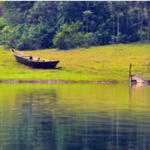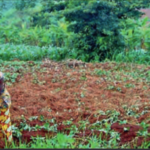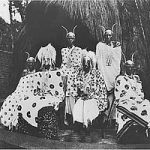Sweet potatoes & Manioc
Although not a traditional food and despite the fact that they were painfully introduced by the Belgian administration to alleviate the periodic famines that occurred in Ruanda, sweet potatoes are probably the “foreign” crop that was best received by the peasants of Remera.
The author did not have the sweet potatoes grown in Remera identified by a botanist, but, judging by the leaves they produce, there are at least two kinds. The peasants, with a variety of criteria, have many names for them.
Sweet potatoes are very nearly the only crop sown on the bottomlands of the marshes; they are then called imirenzo.The bottomlands were not cultivated customarily, but, just as the sweet potato itself was introduced to alleviate famines, so was cultivation of the bottom lands imposed upon the natives. They were taught to drain the marshes by digging ditches that took the water around high beds, usually about five yards wide by twenty-five yards in length. These are the only areas cultivated during the dry season, and, as a result, they furnish the food for the shortage period that used to occur precisely because there was a drought season. Yet, even while the author was in Remera, it took some persuasion on the part of the chieftain to send the peasants to the marshes to cultivate during this season. Sweet potatoes planted in July in the bottomlands begin to be ready for gathering in January, and therefore supplement the harvest from the short growing season. Otherwise, there would not be sufficient food to replenish the stores of the primary season, depleted by the long period between June and January during which there are no crops.
Many fields of sweet potatoes are maintained the year round on lands other than those in the marshes. During the rainy season, these fields can be kept at their original size, or even enlarged. By the simple method of preparing the ground next to the existing patch and transplanting cuttings from the plants as one digs the tubercles out for use. When a new field is planted on the hill, it is usually planted in March and first harvested in September.
Manioc
Manioc is another crop imported by the Belgian administration to ward off famines. Each household head was held responsible for cultivating one-eighth of an acre of manioc.This cloud be sown in bush land on well-drained slopes, apart from each household’sland holding. It is usually untended and is often overgrown with bushes. The natives of Remera do not like to eat manioc.The fact that they adopted it may be due to its storage quality; it seems that its edible root can be left in the ground for years without spoiling. When there is nothing else to eat, the peasants of Remera resort to manioc. No one ever readily admits to eating manioc, but, of course, it is eaten. In the form of flour, it may also be mixed with meat stock.
https://uk.amateka.net/sweet-potatoes-manioc/https://uk.amateka.net/wp-content/uploads/2021/03/patates-doucemanioc.jpghttps://uk.amateka.net/wp-content/uploads/2021/03/patates-doucemanioc-150x150.jpgAgricultureModel CitizenshipAlthough not a traditional food and despite the fact that they were painfully introduced by the Belgian administration to alleviate the periodic famines that occurred in Ruanda, sweet potatoes are probably the “foreign” crop that was best received by the peasants of Remera. The author did not have the sweet...BarataBarata rpierre@ikaze.netAdministratorAMATEKA | HISTORY OF RWANDA




